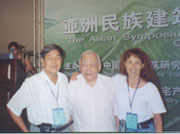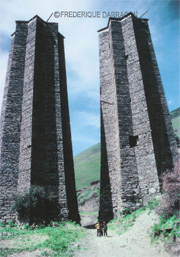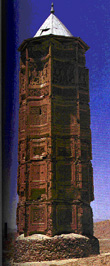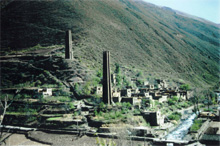STONE TOWERS PROJECT
Dating the towers and researching their history, mapping them and helping the local governments enlisting them as National Cultural Relics, working with provincial governments and other western NGOs to organize the Towers restoration following UNESCO standards, involving all the stake-holders in drafting and implementing a sustainable tourism management plan for the whole area.
SICHUAN PROVINCE AND TIBETAN AUTONOMOUS REGION
Presentation of the project to the UNESCO World Heritage Center in Paris : June 2003
 |
Professor Jiang, professor Chen
and Frederique
|
Historic
Starting in 1998 Frederique has been traveling in Kham (part of the tribal corridor of South west China) to locate the towers still standing and collecting wood samples from their now broken interior beams. Over 60 samples were sent to Beta Analytic in Florida USA, for carbon dating. She also has been meeting and corresponding with numerous Tibetan, Chinese and western experts, as well as researching past and contemporary publications in libraries. She has also sponsored some related research and work by Chinese experts. (including some work by Professor Chen Zungxiang)
Click here to go to Beta Analytic website
 In 2001 she filmed her first documentary, a 45-minute film on the Towers that was, bought by the Discovery Channel in 2003. It is now being shown all over the world. In 2001 she filmed her first documentary, a 45-minute film on the Towers that was, bought by the Discovery Channel in 2003. It is now being shown all over the world.
Newsweek International dedicated a full page to this documentary.
(See “In The News”)
In June 2003 Frederique introduced the towers of the tribal Corridor of South West China to Mr. Francisco Bandarin,
director of the UNESCO World Heritage Center and to Mr. Jing Feng, head of the Center Asia department.
 Both were very impressed by these amazing constructions they had never seen, and Mr. Bandarin immediately noted that he knew of another ancient construction of such “star” shape in Ghazni. Both were very impressed by these amazing constructions they had never seen, and Mr. Bandarin immediately noted that he knew of another ancient construction of such “star” shape in Ghazni.
Further research by Frederique demonstrated that, worldwide, the ONLY other Star-shaped towers were the ones built by the Ghaznavid and Seljuk (Turkish) dynasties ONLY from the 11th to the 12th centuries, and ONLY in the lands that they had then occupied-- modern day Iran, Tajikistan and Afghanistan.
The World Heritage then issued a letter of recommendation to Frederique enabling her to work in cooperation with the local governments and assist them in clarifying the requirements of the Heritage's program about authenticity, integrity and protection of the towers sites. In April 2004 a two- page article was published by the prestigious Smithsonian Magazine about the Towers. There was also a short story in Science Magazine.
Click here to see the full Smithsonian article
In June 2004 Frederique was invited to present her research at an Architectural Conference organized in Beijing by the Chinese Educational Television (CETV). The Unicorn foundation is in talks with CETV to cooperate on the production of educational tapes to be used in the schools to educated and inform children and adults. She also was invited to present her work at a symposium organized, in Chengdu, by the Beijing National Architecture Academy. (See letter by Ji Xuming, director of this Academy in “In The News”) or
Click here for the Beijing National Architecture Academy
In July 2004 Frederique was invited to the World Heritage Annual Meeting held in Suzhou as an NGO observer. , , , There she was able:
-to study all the requirements for a successful nomination
-to present, in her own name only, the towers project to many delegations who were all astonished by these extraordinary constructions,
-to meet with various experts and other foundations who could help her draft a management plan.
An Institute to coordinate the research
On August 5th 2004, the Sichuan University Unicorn Heritage Institute was created. It is a joint effort between the Unicorn Foundation and Sichuan University, and aims to research, record and preserve the past and present cultures of western China, and more specifically to assist local governments in establishing effective management plans. The Institute will also work with the Chinese government in preparing the nomination of the Towers' sites to the UNESCO World Heritage List.
Situated in Chengdu, capital of Sichuan Province, the Sichuan University is one of the oldest and the third largest University in China with student body of 50.000 students from all over China. It is the leading University in three fields.
Click here for Sichuan University web site
About these ancient and extraordinary sky-scrapers
More than 200 full size towers still grace the forgotten valleys and the inaccessible mountain tops of what is called and “Kham” by the Tibetans, and the “Tribal Corridor of South-West China” by the Chinese. In an area 2/3 the size of France, one finds these towers, many of them in the shape of star shapes yet to be seen elsewhere in the world. The Towers are located in four main regions: Three areas in Sichuan Province, were the Qiang Minority, the Jiarong Tibetans and the Minyag Tibetans live, and one area is in the South West of the Tibetan Autonomous Region of Kongpo.
These towers are all built of uncut stones, skillfully stacked using little mortar. Their masonry is unique in that wooden beams are nearly always inserted inside the stone work.
The Qiang towers, which have been used and repaired until recently are impossible to date via the wood used in their construction. Frederique has, until now, dated a total of 56 towers using Carbon 14 technology. The oldest tower could be as old as 1200 years and the newest only 470 years. The majority of the towers are about 700 years old.
Nowadays, people in these areas of Sichuan, communicate in Mandarin Chinese or in Kham Gay (a sort of Tibetan Lingua Franca). These four regions still have a total of nine different and mutually unintelligible languages (not counting each of these languages' dialects). None of these nine languages have a written form.
The Qiang practice ancestor-worshiping (as most Chinese have done until recent times), and the Jiarong are still largely “Bonpos”.
Various sects of Buddhism have been the religion of many inhabitants of these regions since the 11th century but still nothing has yet been found about the towers in Buddhist books.
 |
Songgang towers |
Consequently, very little is known about the history of the various tribes who populated the area at the time of the construction of the towers, and even less is known about the history of the towers.
2000 years ago, 40- meter tall square towers already existed in the mountains of northern Sichuan and the South of the Tibetan Plateau ( were the Nan Mon tribe was said to live), since they are briefly mentioned in the late Han annals. The “star” shaped towers were only mentioned in Chinese ancient writings around the middle of the Ming Dynasty.
An archeological study of these primordial towers (most of which have been unused for half a millennium) is of vital importance and we are preparing one in cooperation with the Sichuan Government.
Towers already in poor shape are being destroyed on purpose to use their stones and the land on which they stand to build new houses. The Jiarong, Minyag and Kongpo Tibetan and Qiang populations are nowadays quite impoverished and it is imperative to help the locals take measures to protect these extraordinary sites which are part of mankind's cultural heritage.
They used to be counted by the hundreds but today, in an incredible architectural feast, only dozens of towers more than 25 meters tall are still hugging the steep slopes of the Danba's valleys.
The 18 towers dated by Frederique using Carbon 14 technology are all between 500 and 850 years old, the oldest towers being in Suopo and Pujiaoding were gold has been mined for approximately 2000 years. That would explain the precocious wealth in the area.
But these luxurious valleys might be the legendary "Kingdom of the Women of the East" whose queen, in the Tang Annals, is purported to have lived in a 40-meter high tower 13 centuries ago. Consequently some towers might be much older.
This area was also the site of the famous 18th century “Gyalrong Wars”. The armies of the Manchu Emperor, Qiang Long, fought two wars lasting 30years against the local inhabitants who built thousands of towers to defend themselves. These towers, which, on the drawings dating from the period of the wars and kept in Taiwan, looked fairly different from the towers now standing, must all have been bombarded down at the time by the Chinese armies using the Portuguese Jesuits' canons. Frederique has not fond yet any tower dating from the 18th century.
|
About the Bamei, Wari, and Zaba towers
The Minyag were called Dang Xiang Qiang in ancient Chinese texts. Some Minyag tribes were reported to inhabit the valleys along the Yalong River since before the Tibetan Empire.
Many Minyag scholars consider the region stretching from today's Daofu to Yajiang as part of the Minyag cultural area. It is said that, in that area, towers used to be counted by the hundreds. Today only a few dozens of ancient towers are still of meaningful size and most of them are star-shaped. All these ancient star-shaped towers are of the 8 outward pointing corner kind but for two; one which has 6 outward pointing corners and one which has 4 outward pointing corners on one the side facing the valley and a wall featuring one single corner on the other, facing the mountain, side.
Most of these towers seam to have been attached to house and used for defense as were the Qiang towers; and as in the Qiang towers, the door is usually, but not always, at ground level.
The side facing the valley has loopholes and the side facing the mountain has large doors. On that side one can still often still see the ruins of a house.
Most of the towers are found in Wari (at least 7 star-shaped towers and one square) or around Zaba (two star-shaped towers and one square).
|
